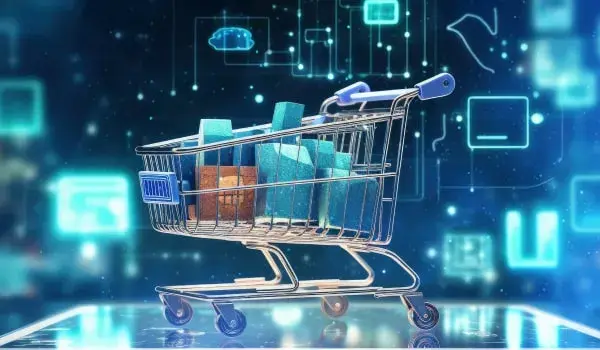Transform your business-to-consumer operations with SAP Commerce Cloud! Read the new article and discover how SAP helps E-commerce businesses simultaneously unlock business agility and improve customer experiences with a ready-to-use, omnichannel solution.
How SAP Commerce Cloud Transforms B2C Commerce Business
It's important for you to give your customers a reason to stay loyal to you. You can achieve this by reacting quickly to changing market conditions, personalizing and presenting relevant content, and thus drawing attention to your services and products at the right moment. Read on to learn more about how SAP software tools help to increase customer loyalty and address the widespread challenges in E-commerce.
What is B2C E-commerce?
B2C E-commerce, in contrast to B2B transactions which involve business-to-business sales, directly targets individual consumers. This model encompasses selling products and services to private customers through various online channels such as dedicated websites, marketplaces, or social media platforms.
The primary focus in B2C E-commerce is to provide an appealing product presentation and ensure a user-friendly and straightforward ordering process. Unlike B2B, purchases in B2C are often driven by personal enjoyment rather than purely fulfilling a necessity.
Key elements in B2C E-commerce that play pivotal roles include:
- Omnichannel marketing: Marketing in B2C E-commerce is about creating a compelling brand presence, engaging advertising, and strategic promotion to capture the attention of individual consumers. It involves tailoring messages to resonate with personal preferences and lifestyles.
- Customer loyalty: Establishing and maintaining customer loyalty is crucial in B2C E-commerce. This involves building strong customer relationships through personalized experiences, rewards programs, and excellent post-purchase support, fostering long-term connections and repeat business.
- Customer experience: The overall customer experience is paramount in B2C transactions. This includes optimizing the online shopping journey, ensuring a seamless checkout process, and providing exceptional customer service. A positive experience contributes significantly to customer satisfaction and retention.
- Demand generation: Unlike B2B transactions that often revolve around practical needs, B2C E-commerce recognizes the importance of creating desire and enjoyment. Products and services are marketed to evoke emotions, making the buying process an enjoyable and satisfying experience for the consumer.
- Fast delivery: Timely order fulfillment and swift delivery are critical factors for success in B2C E-commerce. Customers expect their purchases to be delivered promptly, and efficient logistics contribute to a positive overall experience, enhancing satisfaction and potentially driving repeat business.
- Customer-oriented support: Responsive and customer-centric support is essential. Whether through live chat, email, or phone, providing assistance and resolving queries promptly contributes to customer satisfaction and can positively influence brand perception.
Emerging online sales channels like messengers and chatbots complement traditional websites and apps, expanding the scope of B2C interactions. However, nowadays, the B2C industry is facing a lot of challenges. Below we will look at the main ones.
B2C Commerce Business Challenges
Companies grapple with the dual challenge of meeting heightened consumer expectations while distinguishing themselves in a saturated market. These systems go beyond conventional, off-the-shelf software packages, instead serving as intricate frameworks that intricately weave together company, customer, and product data through numerous interfaces. Challenges in B2C commerce encompass navigating this complexity, optimizing marketing strategies, fostering customer loyalty, and delivering a compelling customer experience. Let’s look at them in more detail.
Low online sales and Ineffective marketing strategies
Businesses often experience suboptimal online sales, stemming from ineffective marketing strategies that fail to resonate with the target audience. An example could be a retail brand experiencing low conversion rates due to generic ad campaigns that do not effectively communicate the unique value proposition of their products.
Limited customer reach
The challenge of limited customer reach underscores the importance of expanding the brand's online presence to connect with a broader audience. For instance, a local artisanal product seller may face limited reach, hindering growth; optimizing search engine visibility and utilizing social media channels effectively can enhance their reach to a wider customer base.
Inefficient checkout process
An inefficient checkout process, characterized by slow loading times, complex steps, or technical glitches, can lead to abandoned carts and frustrated customers — over 70% of shopping carts are left abandoned, leading to significant lost profits. For example, an online electronics store facing cart abandonment issues due to a lengthy checkout process can improve efficiency by implementing a streamlined, one-click checkout option, ensuring a smoother and quicker transaction for customers.
High customer expectations
Today, almost 9 out of 10 customers are ready to spend more for a great customer experience. If a brand falls short of meeting these expectations, around 60% of customers are open to trying a different brand. Additionally, a whopping 90% of customers expect the same quality of interaction, no matter which channel they use. This emphasizes the crucial role of customer experience in building loyalty and highlights the need for B2C businesses to focus on meeting customer expectations.
Each challenge described above demands strategic consideration and innovative solutions to create a successful and distinctive presence in the competitive E-commerce landscape. But how can a poor user experience be improved?
Market-leading technology providers all rely on proven best practice standards when developing their E-commerce systems, and one of them is SAP Commerce Cloud.
Top Software Development Company 2024
The LeverX project team synchronized the client’s data from disparate sources and streamlined its collection and processing.
The result?
- Robust E-commerce platform with tailored product catalogs
- Refined demand forecasting
- Cost-effective data aggregation and visualization
- Customer experience improvement
SAP Commerce Cloud Benefits for B2C Commerce
Integrated with SAP ERP software like SAP ECC 6.0 or S/4HANA, SAP Commerce Cloud ensures streamlined communication, especially for customer and product data. This detailed understanding and synchronization set SAP Commerce Cloud apart in B2C commerce. With this solution, customers can expect a consistent brand appearance and a user-friendly design across all devices. The platform offers tailored and highly personalized real-time experiences so that users feel engaged directly and individually.
The SAP Commerce Cloud includes the following functionalities for the B2C segment:
Consistent omnichannel shopping experiences
App or web, tablet, or smartphone: SAP Commerce Cloud supports a consistent and targeted shopping experience by optimally adapting content for all touchpoints. Feature parity can also be ensured on all presentation levels via the decoupling of the frontend and backend.
Uninterrupted availability
Ensure continuous system availability for your customers. SAP Commerce Cloud has auto-scaling mechanisms that dynamically adjust server resources based on real-time demand fluctuations, ensuring a consistently smooth and responsive user experience even during peak visitor frequencies.
Global success with diverse sales models
SAP Commerce Cloud is a global success, excelling in international projects featuring diverse websites, currencies, and languages. This versatile platform accommodates multiple sales models, encompassing direct sales to consumers (B2C), indirect sales through distributors and resellers (B2B2C), and direct sales to companies (B2B), providing a unified solution for diverse business needs.
Quality customer experience
Utilize the intuitive SmartEdit, a website editor from Commerce Cloud that features a drag-and-drop interface for crafting websites, pages, promotions, and banners across devices. This unique tool enables users to seamlessly enhance existing designs across multiple storefronts, ensuring a unified and engaging customer experience. For B2C businesses, SmartEdit simplifies design updates, guaranteeing a consistent and visually appealing online shopping journey.
Customer centricity in the first place
Through direct interactions facilitated by SAP Commerce Cloud, entrepreneurs receive immediate feedback, gauging the customer experience. Complementing this, satellite systems such as Service Cloud, Customer Data Cloud, Customer Data Platform, and Sales Cloud operate in the background, storing customer data and orchestrating processes. Leveraging this comprehensive data, companies attain a 360-degree view of customers, enabling precise analyses and empowering the creation of personalized experiences that prioritize individual needs, thus placing customer satisfaction at the core of the B2C experience.
Purchase-to-pay and order-to-cash options
SAP Commerce Cloud offers a distinct advantage in E-commerce integration by ensuring a seamless purchase-to-pay and order-to-cash process. With optimal purchase-to-pay integration, procurement processes are streamlined for efficient transaction handling, while the order-to-cash integration provides a cohesive flow from customer order initiation through fulfillment, invoicing, and payment confirmation.
Transform B2C Commerce With LeverX
Businesses navigating complex B2C environments must strategically leverage sophisticated E-commerce systems to meet and exceed consumer expectations and establish a distinct presence in the competitive E-commerce arena. Experience end-to-end support with LeverX as we employ a comprehensive strategy that begins prior to SAP Commerce Cloud implementation, guiding you through crucial processes, and extends post-implementation with continuous support and system enhancement. By using the SAP Commerce Cloud system, customers experience:
- 30% boost in average basket value
- 35% increase in online sales
- 60% faster launch of new online shops
Here are three distinct advantages of choosing LeverX for implementing SAP Commerce Cloud:
1. Strategic pre-implementation guidance
Our 20-year expertise extends beyond implementation; we provide strategic insights and guidance before initiating SAP Commerce Cloud, ensuring a thorough understanding of your business processes and needs for optimal system integration.
2. Ongoing support and maintenance
With LeverX, the partnership doesn't end at implementation. Our commitment extends into the future with continuous support and proactive maintenance, ensuring your SAP Commerce Cloud ecosystem stays optimized for changing market requirements and aligned with evolving business requirements.
3. Tailored system development
LeverX offers bespoke solutions for ongoing system development, adapting SAP Commerce Cloud to your changing needs. Our approach focuses on enhancing your system's capabilities, fostering scalability, and staying ahead of technological advancements, ensuring a 360° view of customers and a future-proof E-commerce environment.
In a Nutshell
In the dynamic and competitive landscape of B2C E-commerce, businesses face the challenge of meeting the elevated expectations of individual consumers while differentiating themselves in a crowded market. Notably, E-commerce systems like SAP Commerce Cloud deviate from standardized software packages. Rather than offering a one-size-fits-all solution, these systems function as intricate frameworks that interconnect company, customer, and product data through multiple interfaces.
The primary objective is to ensure that this wealth of information is presented clearly and effectively to customers, contributing to a seamless and personalized online shopping experience.
Need guidance when developing a B2C commerce solution for your business? Let the LeverX team know and get personalized advice tailored to your business needs.
How useful was this article?
Thanks for your feedback!


-min-1.jpg)
